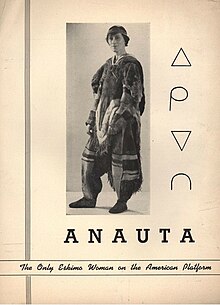Anauta Blackmore
Anauta Blackmore (c. 1890–1965), also known as Lizzie Ford Blackmore, was an Arctic author, memoirist and lecturer.[1] She is best known for her 1940 autobiography, Land of the Good Shadows, which may be the first book-length autobiography of an Inuk.[2] Blackmore claimed to have Inuit ancestry, although it's unclear if this was true.[3]
Early life[edit]
She was born Sarah Elizabeth Ford on Baffin Island in about 1890.[3][4] Her father was George (or Yorgke) Ford, who worked for the Hudson's Bay Company as an interpreter.[3][5] In Blackmore's recounting, her mother was an Inuit woman, although company archives suggest her mother was from Newfoundland and died around 1905.[3]
She married her cousin, trading-post manager William R. Ford, with whom she had two daughters, but was widowed in August 1913 when Ford drowned.[1][4] After this she spent some time in Halifax, Nova Scotia, Montreal, Quebec, and Detroit, Michigan, before settling in Indianapolis, Indiana, around 1920.[1] Here she married construction contractor Harry Blackmore.[1][4]
Career in America[edit]
In Indianaopolis, she met Indianapolis Star cartoonist Chic Jackson who, around 1929, helped her establish herself on the lecture circuit.[1] She embraced her Inuit name, Anauta, was advertised as "the only Eskimo woman on the American platform", and spoke about her life experience in the eastern Arctic.[4]
In 1940, Blackmore collaborated with American children's writer Heluiz Chandler Washburne to write an autobiography, Land of the Good Shadows: The Life Story of Anauta, an Eskimo Woman, published by John Day Company.[4] The story was certainly embellished for a white audience, with Blackmore claiming to have been adopted and raised by an Inuk woman.[4] She would go on to write two more books, Children of the Blizzard (1952), a collection of stories of Inuit children, and Wild Like the Foxes: The True Story of an Eskimo Girl (1956), a biography of her mother.[5]
Blackmore died of a heart attack on 13 January 1965 in Ashland, Kansas, where she had been engaged to lecture.[1][6]
References[edit]
- ^ a b c d e f Thompson, Donald Eugene (1974). Indiana authors and their books 1917–1966; A continuation of Indiana Authors and Their Books, 1816–1916, and containing additional names from the earlier period. Wabash College. p. 54.
- ^ McGrath, Robin; Jenness, Diamond (1984). Canadian Inuit Literature: The Development of a Tradition. National Museums of Canada. p. 85.
- ^ a b c d Considine, John (12 October 2010). Adventuring in Dictionaries: New Studies in the History of Lexicography. Cambridge Scholars Publishing. pp. 282–284. ISBN 978-1-4438-2626-6.
- ^ a b c d e f Crooks, Katherine (October 2020). Cold Comforts: Women Making Inuit and Qallunaat Homes in the Eastern Arctic and North American Cultures of Exploration, 1890-1940 (PDF) (PhD thesis). Dalhousie University. pp. 173–223.
- ^ a b Bataille, Gretchen M.; Lisa, Laurie (16 December 2003). Native American Women: A Biographical Dictionary. Routledge. p. 13. ISBN 978-1-135-95587-8.
- ^ "Anauta dies of heart-attack in Kansas town". The Kokomo Tribune. Associated Press. 15 January 1965. p. 7.
- 1890s births
- 1965 deaths
- Writers from the Northwest Territories
- Writers from Indianapolis
- Inuit writers
- Lecturers
- 20th-century Canadian memoirists
- 20th-century American memoirists
- 20th-century Canadian women writers
- 20th-century American women writers
- Canadian people who self-identify as being of Indigenous descent

